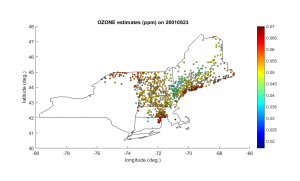Effect of Ozone Exposure on Revascularization Outcomes
Cardiovascular disease (CVD) accounts for 2,300 deaths per day in the US, claiming as many lives as the next four leading causes combined. Epidemiological studies indicate that the majority of air pollution related deaths are related to CVD. One of the major conclusions from the 10-year exposure study, MESA Air (Multi-Ethnic Study of Atherosclerosis Air Pollution Study), indicates that ambient air pollution accelerates the progression of atherosclerosis. Severe atherosclerosis is treated with vascular interventions aimed at re-establishing adequate blood supply to target tissues. Vascular interventions continue to fail, however, from restenosis secondary to neointimal hyperplasia. Neointimal hyperplasia results from a complex interplay of events that occur throughout the vascular wall, but is predominately characterized by proliferation and migration of vascular smooth muscle cells (VSMC) and adventitial fibroblasts to the neointima. The effect of exposure to air pollution on restenosis rates has not been established and is a significant gap in our understanding of how air pollution affects cardiovascular outcomes. Our lab aims to:



